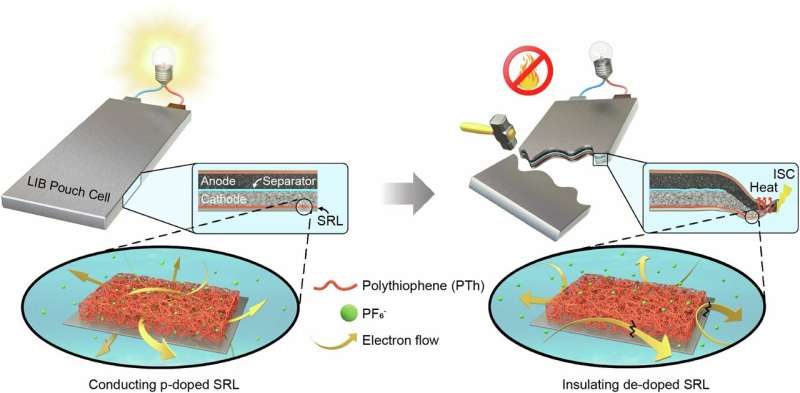Newly developed material can suppress thermal runaway in batteries
A team of engineers and materials scientists at LG Chem, Korea’s largest chemical company, has developed a material that they claim could greatly reduce the risk of thermal runaway and resulting fires in batteries. In their paper published in the journal Nature Communications, the group describes how they developed the material and how well it has worked during testing.
Over the past several years, consumers have witnessed or have heard about batteries in smartphones or cars catching on fire. These fires, it has been found, result from thermal runaway, which is where the anode and cathode inside a battery come too close together, or worse, actually touch.
The result is a short, which generates heat, and results soon thereafter in a fire. In this new effort, the team at LG has developed a thin material that, when placed between the cathode and collector, prevents thermal runaway.
The idea behind the new material is to stop the flow of electricity inside the battery if it starts to overheat. Adding electronic sensors would be too bulky and could suffer heat failure before shutting down electrical flow.
A better idea, the research team suggests, is placing a thin piece of conductive material between the anode and collector, through which current in the battery flows—one that automatically stops being conductive at a certain temperature.
The new material is a metal composite the team at LG refers to as the Safety Reinforcement Layer (SRL). They made a tiny sheet of the material just one micrometer thick and placed it in a traditional battery and then tested its functionality.
They found that beyond normal conditions, where temperatures ranged from 90°C to 130°C, the SRL served as a conductor, allowing current to flow normally. But as temperatures were increased, resistance increased by 5,000 ohms per degree C, resulting in reductions in current. The team also found that the reverse was true—when temperatures were reduced, resistance decreased.
The researchers tested their improved battery in real world conditions as well. In one such test, they hammered a nail into it, a move that almost always makes batteries catch fire, and found that with the SRL in place, either no fire occurred, or a small fire started which was automatically extinguished very quickly. The team also tried squashing the battery with a heavy weight, another surefire way to get a battery to ignite, and they obtained the same results.
The team plans to continue safety testing the SRLs in different sizes and types of batteries with the goal of selling them to battery-makers in the near future.
More information:
In Taek Song et al, Thermal runaway prevention through scalable fabrication of safety reinforced layer in practical Li-ion batteries, Nature Communications (2024). DOI: 10.1038/s41467-024-52766-9
LG: www.lgchem.com/company/informa … -9535?lang=en_GLOBAL
© 2024 Science X Network
Citation:
Newly developed material can suppress thermal runaway in batteries (2024, October 4)
retrieved 5 October 2024
from https://techxplore.com/news/2024-10-newly-material-suppress-thermal-runaway.html
This document is subject to copyright. Apart from any fair dealing for the purpose of private study or research, no
part may be reproduced without the written permission. The content is provided for information purposes only.

Comments are closed